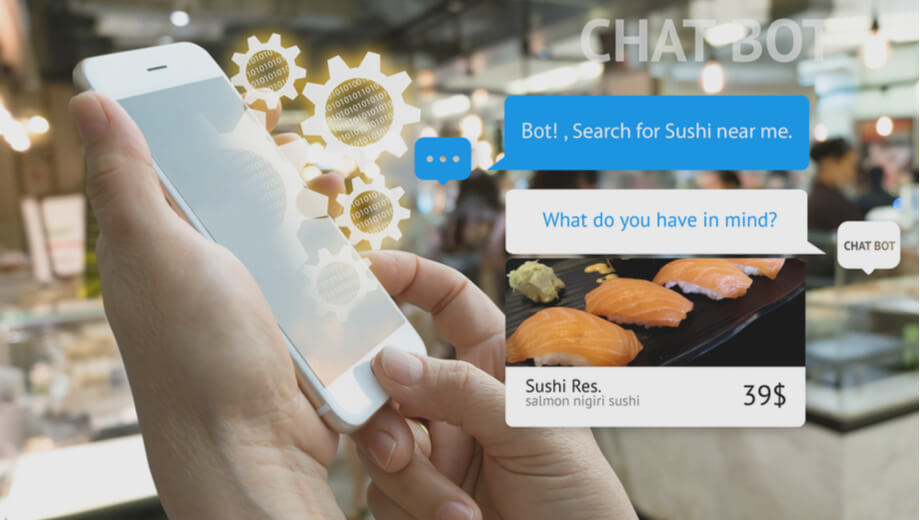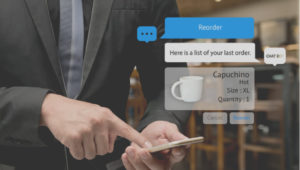The Tech Touch
Bots have become an indispensable tool in helping us navigate through the pervasive digital life we are currently living in. Bots are swiftly replacing human interaction to become the new user interface in all of our digital transactions. Underlying the development and design of bots are the new technology enablers, Artificial Intelligence (AI) and Machine Learning ( ML)
Various scenarios like Sentiment Analysis , Natural Language Understanding , and Frequent Context Switching are becoming possible due to the application of Al and ML.
Interaction with Bots may be via any of the communication channels like Text, Video and even Emojis. Bots like Alexa and Siri have features that integrate with IoT devices and use Voice commands. For the purposes of search marketing, businesses rely majorly on chatbots.

The Plus Point
What makes the usage of bots in marketing useful and interesting is the capability of Memory. This property enables bots to derive Consumer Intent from the conversation at different times and perform actions based on this, making bots cost-effective marketing tools for customer engagement.
To effectively deal with consumers, a deep understanding of human behaviour is a prerequisite. Consumers are becoming more and more demanding, seeking instant gratification. Patience is not a virtue of a sharp customer. Bots provide a means to satisfy this user expectation in a time and cost-efficient manner. As the programme seeks to mimic human communication, the engagement is often structured to try and not sacrifice the emotive component.
Chatbots are now commonly used across businesses to develop close links with clients. Almost all brands use chatbots to give their customers a seamless user experience. This tool allows for deeper relationship-building between the brand and the customer. Customer support services and running help desks are typical examples of how chatbots are replacing back-end human interaction.
The current exponential growth of e-commerce business, with the pandemic adding to the push, has made customer services centre stage. Platforms are now using chatbots to not only provide quick solutions to customer grievances but also to showcase products, their details and specifications. Alternatives and suggestions, follow-up emails are in-built persuasions to captivate the customer. Most importantly, Bots enable overcoming time, space and cost constraints in such customer-centric areas.

The Value Proposition
The value provided by online interactions really matters for the digital customer. Bots have therefore become intrinsic to any marketing strategy. They provide an easy, convenient way to engage with a consumer with personalized offers. This characteristic of bots makes it a powerful tool for both digital marketers and enterprises. Targeted marketing campaigns, riding on bot technology, can be easily developed with better results in terms of lead generation, conversion and sales. Feedback loops allow for modifications, amendments and determining consumer trends and preferences.
Insider Intelligence has forecast that by 2024 consumer retail spend via chatbots worldwide will go up dramatically from $2.8 billion in 2019 to $142 billion.
The Voice Choice
Other than chatbots, voice-based intelligence is gaining popularity. Take the examples of Amazon’s Alexa, Apple’s Siri and Google Assistant. Voice commands to and interaction with such virtual assistants, are often used as search engines, without the need to actually log on. Day-to-day chores like to-do lists, finding weather conditions, information about facilities near the user, playback music and other media, online shopping, etc., are examples of some functional possibilities of voice-controlled bots.
Digital marketers can derive value for their product/service from consumers’ use of this technology. Improving their presence in this space and being one of the preferred hits offers ample scope for targeted marketing.
The Other Channels
In today’s digital marketing era, businesses employ multiple channels to maximize value. Current online marketing tactics include PPC (Pay Per Click) advertising, Personalized Messaging, Content Generation, Web designing and Optimization, Search Engine Optimization, Business and Consumer Data Analytics, etc. The intent is to use the technology as enablers to deliver products and services of choice in a more responsive, proactive and personalized way.
The Core Purpose
In keeping with the objective of maximizing value for both the enterprise and its customers, marketers choose bots for performing the following core functions:
- Communication: This does not mean just conversations but covers the entire gamut of engaging with any visitor to the enterprise’s website. Beginning with the home page aesthetics, interface graphics, information display and ease of navigation around the various touchpoints, etc., to captivate the visitor. Making the experience immersive calls for superb marketing and technological skills.
- Data Analytics: This is applied to know customer preferences and trends, lead gathering, segregation and management, demographics and customer profiling and, in general, analyze traffic.
- Support: Customer support and sharing new, updated information.
- Performance: Monitoring, Tracking and Performance measurement
The Examples
Some great examples of the use of bots, chatbots, in particular, are in the retail business, restaurant and food business, travelling and leisure, Health care, finance, etc.
For instance, Domino’s, the pizza chain, a chatbot on Facebook, easily allows customization of orders with preference saving to make repeat orders of favourites a simple task.
Sephora, the cosmetics brand, guides purchasers through a variety of actions and acts as a virtual concierge, all within Messenger.
In the sphere of health care, WHO ( World Health Organisation) launched a chatbot service, WHO Health Alert, in association with WhatsApp and Facebook to counter misinformation and myths about the Covid19 virus.
In the finance world, the Commonwealth Bank of Australia launched Ceba to assist customers with more than 200 banking tasks.
The Way Onwards
There are a plethora of cases on multiple platforms like Facebook Messenger, Slack, WeChat, WhatsApp, etc., cutting across industries and market segments that show how bots enhance customer experience and save substantial operational costs for businesses. Insider Intelligence estimates that the adoption of chatbots could save the banking, healthcare and retail sectors up to $11 billion annually by 2023.
Though there are many success stories, bots failures also exist. Success is not guaranteed. Poor quality bots created after improper and inadequate understanding of the brand and its customers’ needs, can be quite damaging. Even though bots can be created by oneself through handy solutions and services, like that provided by Microsoft, looking at the high stakes of branding and product reputation, it may be more appropriate if the matter is outsourced to competent firms who specialize in bot creation. An agency like Neuronimbus that excels in providing digital transformation will provide meaningful solutions. Their in-house expertise has developed NeoBot, an enabling tool for enterprises to streamline many processes like client management, retail, sales and marketing, etc. Neuronimbus has the capability to recommend and implement best fit digital marketing strategies to maximize returns.
If your business wants to continue to be relevant in the public eye, reach a wider, targeted audience in a personalized way with cost-effective efficiency, using bots will be a good way to have your ear to the ground and protect your hard-earned interests.



